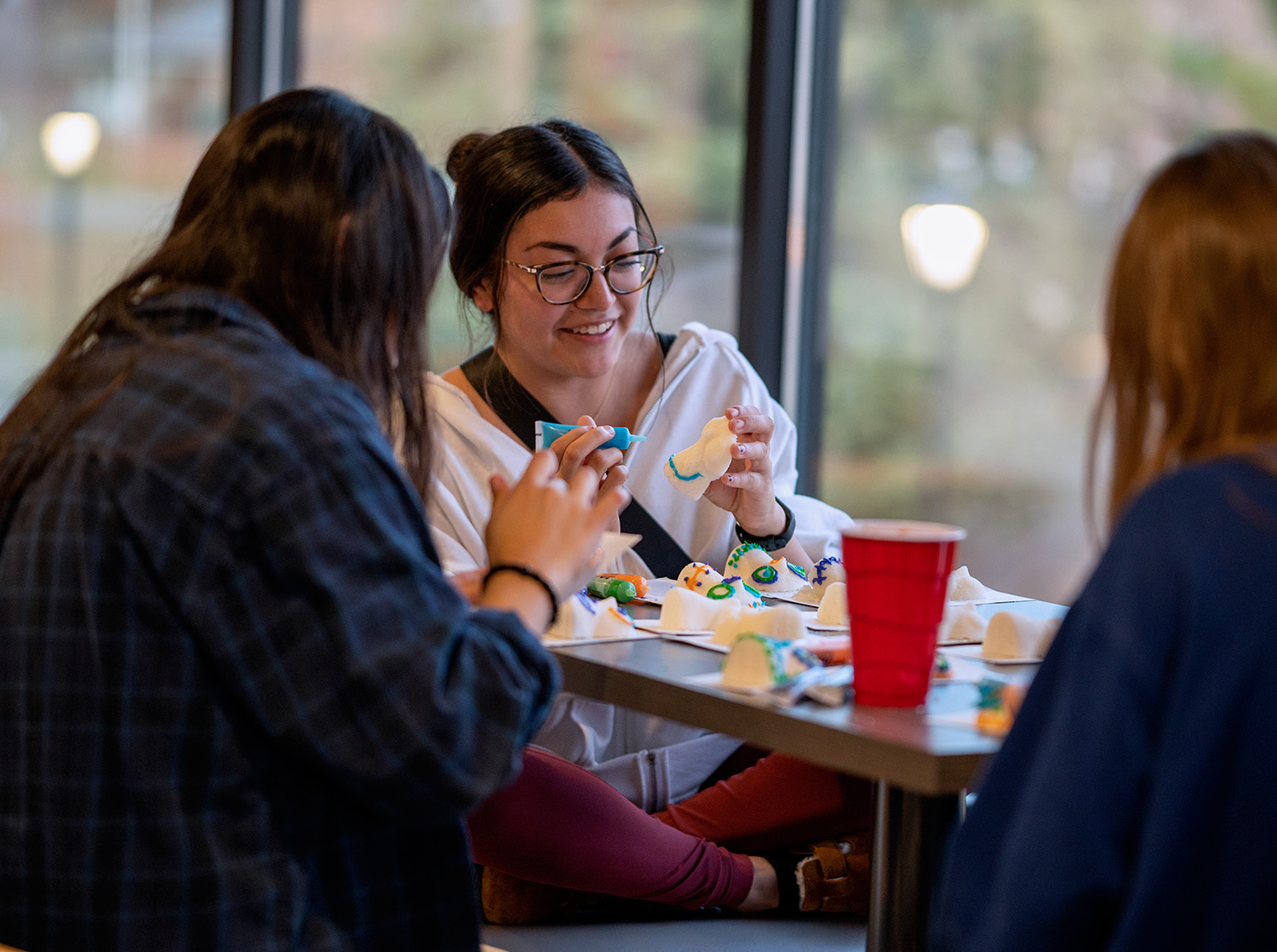We're Here For You
Finding support should be easy. That's why we've compiled a comprehensive list of resources to help you access the services you need - on and off campus.
Have questions or need more info? We're here to help! Email us at inclusion@uwrf.edu.

Available Resources
- Disability Resource Center
- Financial Aid
- Grants
- Scholarships
- International Student Services
- Dr. Robert B. Bailey III Office of International Education
- Preferred Name Policy: Staff
- Preferred Name Policy: Students
- Report It! (Bias Incident Reporting)
- Student Health and Counseling Services
- Student Involvement
- Student Support Services (SSS/TRIO)
- University Police
- Upward Bound
- Violence Prevention Coordinator
The Mediation Room, located in Rodli Hall next to the Student Inclusion and Belonging Center (room 269), is an interfaith space open to all faculty, staff and students. It offers a welcoming environment for prayer and meditation, featuring designated areas for men and women, along with washing stations to support diverse spiritual and reflection needs.
In this self-paced online course, you will explore the similarities and differences between these identities, the impact of stereotypes and bias on LGBTQIA+ individuals and communities and the role of allyship in supporting gender identity and sexual orientation.
Allyship
At its core, allyship is about respect, support and taking meaningful action. Being an ally is not just about what you say—it’s about what you do.
An ally is typically someone from a dominant or majority group, but anyone can be an ally. While straight and cisgender individuals often serve as allies, LGBTQIA+ individuals can also act as allies to other marginalized groups within the community.
Allies advocate for LGBTQIA+ individuals by actively opposing homophobia, biphobia, transphobia, cissexism and heterosexism. They show their support in personal and professional spaces, standing up against oppression and fostering inclusivity. An ally can be:
An activist speaking out against discrimination
An educator raising awareness
A supporter providing a safe space
A role model demonstrating respect and inclusion
An automatic expert on LGBTQIA+ topics.
A trained counselor.
A spokesperson for LGBTQIA+ individuals or other allies.
True allyship requires continuous learning, listening and taking action to create a more inclusive and equitable world.
Gender-Inclusive Facilities
Residence Life hosts a Gender-Inclusive Community in our residence halls.
There are accessible, all-gender restrooms located across the UWRF campus in most buildings. Many of these restrooms are single stall and wheelchair accessible. Please contact Facilities Management at facilities@uwrf.edu or 715-425-3827 with questions regarding restroom locations.
Gender Pronouns: Creating an Inclusive Community
At UWRF, we're committed to fostering a welcoming and inclusive environment where everyone feels seen and respected. Using the correct pronouns is a simple, yet powerful way to show support for our transgender and gender non-conforming students. It affirms their identity, validates their experiences and helps create a safer, more inclusive community.
Misusing pronouns—whether intentional or not—can be harmful. It can even "out" someone in an unsafe situation. That’s why asking and using the correct pronouns is as important as using someone’s name.
Want to learn more? Explore our guide on:
What pronouns are and why they matter
Gendered vs. nonbinary pronouns
How to ask about pronouns respectfully
What to do if you make a mistake
How to support others in using correct pronouns
Take a moment to educate yourself and help make UWRF a more inclusive place for all!
A pronoun is a word that is used instead of a noun or a noun phrase to refer to individuals. Pronouns can be in the first person singular (I, me) or plural (we, us); second person singular or plural (you); and the third person singular (e.g. she/her, he/him, they/them, ze/hir) or plural (they/them).
Gendered pronouns specifically reference someone's gender: he/him/his or she/her/hers.
Non-gendered or nonbinary pronouns are not gender specific and are often used by people who identify outside of a gender binary. The most common set of nonbinary pronouns is they/them/their used in the singular (e.g. Jadzia identifies as genderqueer; they do not see themselves as either female or male.) Other nonbinary pronouns include ze (pronounced "zee") in place of she/he, and hir (pronounced "here") in place of his/him/her (e.g. Jadzia runs hir own business, but ze is more well-known an an author).
It's okay! Everyone slips up from time to time, even those of us who do do this for a living. The best thing to do if you use the wrong pronoun for someone is to say something right away, like "Sorry, I meant she." If you realize your mistake after the fact, apologize in private and move on.
A lot of the time it can be tempting to go on and on about how bad you feel that you messed up or how hard it is for you to get it right. But please, don't! It is inappropriate and can make the person who was mis-gendered feel awkward and responsible for comforting you, which is not their job. It is your job to remember people's personal gender pronouns (PGPs). Take an active role in your education.
In your classes, you may hear one of your students using the wrong pronoun for someone. In most cases, it is appropriate to gently correct them without further embarrassing the individual was has been mis-gendered. This means saying something like "Actually Xena uses the pronoun she or they," and then moving on. If other students or faculty are consistently using the wrong pronouns for someone, do not ignore it! It is important to let your student or classmate know that you are their ally.
It may also be appropriate to approach them and say something like, "I noticed that you were getting referred to with the wrong pronouns earlier, and I know that can be hurtful. Would you be okay with me taking them aside and reminding them about your personal pronouns? I want to make sure that this group/class is a safe space for you." Follow up if necessary, but take your cues from the comfort level of your student or classmate. Know that your actions will be appreciated.
In most cases, you may gently correct the person who made the mistake without further embarrassing the individual who was misgendered. You can say something like, "Actually, Jadzia use 'they' for themselves."
Keep it simple. Try asking, "What pronouns do you use?" or "Can you remind me what pronouns you use?" It can feel awkward at first, but it's not half as awkward as getting it wrong or making a hurtful assumption.
You can also ask as part of an introduction exercise. You will quickly want to explain what a PGP is. Try something like this: "Tell us your name, where you come from, and your personal pronoun. That means the pronoun that you use in reference to yourself. For example, I'm Sarah, I'm from Minneapolis, and I like to be referred to with they, them, and their pronouns. So you could say, 'they went to their car' if you were talking about me."
Identity development is a fluid process. Individuals may still be getting comfortable with their own gender identity and expression. Make sure to let your students or classmates know that if they would prefer to use different pronouns in the future to communicate that with you and that you will respect their wishes.
You can't always know what someone's PGPs are by looking at them. Asking and correctly using someone's personal pronouns is one of the most basic ways to show your respect for their gender identity.
When someone is referred to with the wrong pronoun, it can make them feel disrespected, invalidated, dismissed, alienated, or dysphoric. Often it can make them feel all of the above.
It is a privilege to be cisgender and not have to worry about which pronoun someone is going to use for your based on how they perceive your gender. If you have this privilege, yet fail to respect someone else's gender identity, it is not only disrespectful and hurtful, but also oppressive.
(Cisgender or cis-gender: Noting or relating to person whose gender identity corresponds with that person's biological sex assigned at birth. Definition from Dictionary.com)
She/her/hers and he/him/his are the most commonly used pronouns. Some people call these "female/feminine" and "male/masculine" pronouns. Many avoid these labels because, for example, not everyone who uses he feels like a "male" or "masculine". The downloadable list above is much more comprehensive and will guide you on the appropriate use of each type of pronoun.
There are lot of other gender neutral/gender inclusive pronouns in use. Here are a few that you might hear:
- They/them/theirs - This is a pretty common gender neutral pronoun. Yes, it can in fact be used in the singular. For example: Xena ate their food because they were hungry.
- Ze/hir/hirs - Ze is pronounced like "zee". It can also be spelled zie or xe. It replaces she/he/they. Hir is pronounced like "here" and replaces her/hers/him/his/they/theirs. For example: Xena ate hir food because ze was hungry.
- Just my name please! Some people prefer not to use pronouns at all, utilizing their name as a pronoun instead. For example: Xena ate Xena's food because Xena was hungry.
Never, ever refer to a person as "it" or "he-she" (unless they specifically ask you to.) These are offensive slurs used against trans and gender-nonconforming individuals. Some individuals will reclaim these words for themselves as a form of empowerment. Do not reclaim these words for them.
Student Inclusion and Belonging
Office: Monday-Friday, 8 a.m.-4:30 p.m.
Lounge: Monday-Thursday, 7:30 a.m.-7:30 p.m.; Friday 7:30 a.m.-5 p.m; Closed on weekends

